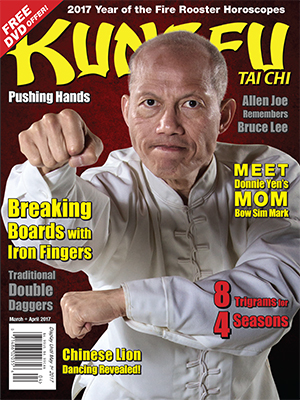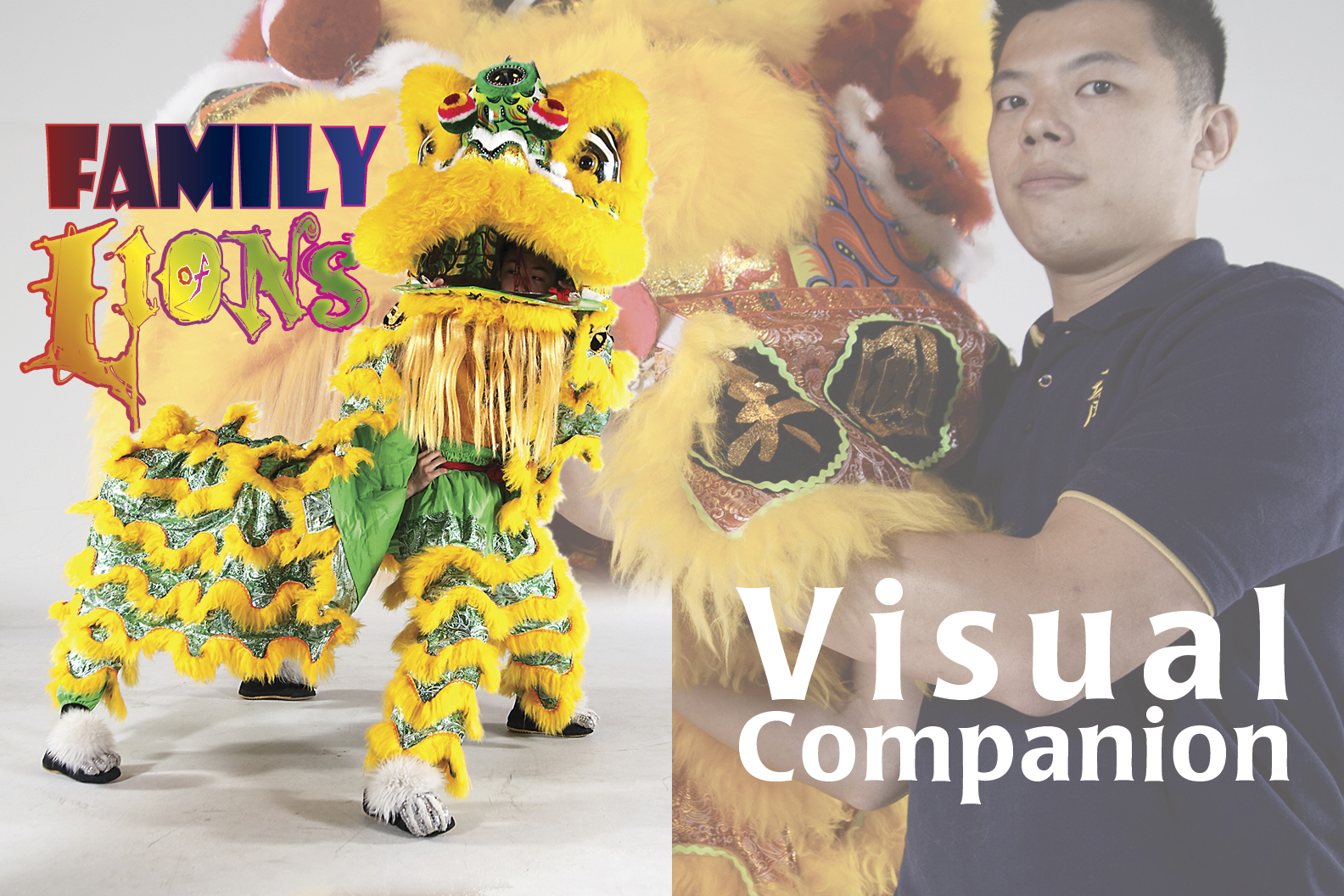By Jeff Hung and Stephen Chew
Buy this issue now , or download it from Zinio
 A tall column of smoke filled the skies of San Francisco’s Chinatown as the sound of 10,000 firecrackers burst into the sunny August afternoon. The thunderous roar of synchronized drumming gathered the onlookers celebrating the 30th Anniversary of San Francisco’s branch of the Shaolin Yau Kung Moon Sports Association. The portrayal of an awakening dragon kicked off four unique lion dance performances followed by demonstrations of Yau Kung Moon style Kung Fu.
A tall column of smoke filled the skies of San Francisco’s Chinatown as the sound of 10,000 firecrackers burst into the sunny August afternoon. The thunderous roar of synchronized drumming gathered the onlookers celebrating the 30th Anniversary of San Francisco’s branch of the Shaolin Yau Kung Moon Sports Association. The portrayal of an awakening dragon kicked off four unique lion dance performances followed by demonstrations of Yau Kung Moon style Kung Fu.
As the evening approached, the festivities relocated to the historic Far East Cafe. Another captivating performance by dragons and lions accompanied by the driving rhythm of the drum, gong and cymbals enthralled guests and tourists. A host of dignitaries proceeded to fill both floors for a lavish banquet. Rose Pak, a local political activist, and the San Francisco police regaled the audience with colorful tales from Yau Kung Moon’s inception during the wild days of Chinatown, and how the association became a leading voice as the community evolved. An auspicious 8 lion awakening and a spectacular Kung Fu demonstration capped off the evening entertainment. Masters or their top disciples represented a spectrum of styles. YC Wong (Hung Gar), Lily Lau (Eagle Claw), John Leung (White Crane), Siu Hung Li (Choy Li Fut), Rick Wing (Northern Shaolin) and Tat Mau Wong (Choy Li Fut) were just a few of the luminaries in attendance. The exhibition concluded with the leadership of Yau Kung Moon demonstrating the intricacies of their style.
Yau Kung Moon traces its roots back to the Shaolin Temple. Early last century, the patriarch Ha Hon Hung studied both Kung Fu and Dit Da from a Shaolin monk named Tit Yan Sim See (鐵隱禪師) in China. Ha was the first secular student of Tit Yan to master his skills. Impressed with Ha’s level of understanding, Tit Yan directed Ha to teach Kung Fu to others and to call the style Yau Kung Moon. The lineage passed through his son, Sifu Ha Kwok Cheung (夏國璋), onto his grandson, Sifu Ha Tak Kin (夏德建), who directs Yau Kung Moon International from their base in Hong Kong.
While in Hong Kong, Yau Kung Moon became renowned for its dragon and lion dancing. Under the direction of Sifu Ha Tak Kin and his son, Sifu Ha Kingmen (夏敬文), the team performs over a thousand shows every year. They have taken part in countless notable events such as China’s President Jiang Zemin’s visit to Hong Kong in 1997 and the equestrian competition at the 2008 Beijing Olympic Games. As a family, the Ha’s are focused on spreading the culture of dragon and lion dancing.
The Ha family travelled to San Francisco for the anniversary celebration in which Sifu Ha Kingmen played a major role in choreographing the dragon and lion dances. After the celebration, Sifu Ha and many of the senior leadership from San Francisco Yau Kung Moon visited the Tiger Claw headquarters to share their insights on lion dancing’s past and their view on its future.
Before the '90s, most southern lion dance followed a decidedly traditional script. A lion dance performance not only entertained but also bestowed good fortune and chased away evil. A show typically took an average of 30 minutes to complete. The choreography drew inspiration from folk rituals integral to Chinese culture. Lion dance also gave Kung Fu schools a chance to demonstrate their martial arts prowess in a non-combative format. While props, like benches and pots, had their place, they were secondary to stacking, a technique in which the head dancer jumps up and lands on the thighs or shoulders of the tail dancer. Stacking was a core skill that reflected the strong stances, power generation and solid footwork of a Kung Fu style.
During the '90s, southern lion dance evolved with the advent of international lion dance competitions, which emphasized showmanship. Instead of shows taking 30 minutes and more, a performance must be completed in less than 10 minutes. As a consequence, many of the traditional and cultural rituals of lion dancing were condensed. For example, a traditional routine may make three long “tests” or approaches to an object, highlighting the importance of three as a lucky number in Chinese numerology. A modern routine may substitute three “short” tests, perform only one long test or merely represent the tests symbolically. To heighten the excitement in the abbreviated time, lion dance teams emphasized more acrobatic moves taken from northern lion dance with its Beijing opera roots and displayed fewer of the stylistic moves originating from Kung Fu.
Sifu Ha Tak Kin recalls telling his father that most people in the audience did not grasp the rituals expressed in a traditional performance. He convinced his father to utilize the shorter tails that allowed more acrobatic routines. He also incorporated shoulder straps under the tail in addition to the waist strap to keep the tail from flying around while jumping. He felt that the lightness training of Yau Kung Moon would benefit the switch to routines on poles that were high off the ground and spread far apart.
Sifu Ha and his son embrace the modern innovations to lion dancing. In addition to the change in routine lengths and the addition of flashier movements, they have observed evolution in music as well. Traditional music was slower in tempo, which gave the lion more opportunity to stalk and display a range of emotions. Sufficient time allowed the performers to tell a more complex story. Modern music has a faster tempo and, much like a music video versus a movie, allows for a story to be developed in less time.
Yau Kung Moon has also experimented with adding new instruments such as a five-pitch wood block, Chinese horns, and wind chimes. The complexity of sound from traditional instruments was expanded by adding drums, gongs and cymbals with different pitches. This combination of new instruments and richer sounds enables the music to fully express the emotions of the story.
Although Sifu Ha integrates the changes arising from modern lion dance, he still requires his team to learn and understand all of the traditions that make up lion dancing. These traditions perpetuate the cultural aspects of Kung Fu training. If a modern routine condenses or removes a tradition in the name of expediency or entertainment, the players should consciously recognize the omission and see what the new routine has done to preserve the cultural significance.
Yau Kung Moon utilizes lion dance levels to ensure that traditions are correctly passed down to the next generation. Similar to a belt system, the level system organizes the body of lion dance knowledge, simplifying the teaching process and preventing details from being lost. Sifu Ha divides their lion dance curriculum into seven levels of achievement. For example, level one emphasizes basic stances and movements. As a student progresses through the levels, both cultural aspects and technical details are added to the training. Each level has its own series of tests the student must surmount before advancing to the next level. This method allows students of all levels to train together as the higher levels build on the foundation of the lower ones.
A major traditional component that students must understand is the Choy Chang (採青). Literally, choy chang translates to “picking the greens” and refers to the climax of most lion dance routines in which the lion picks a lettuce or green and shares it with the audience. In addition to describing the specific action, the term can also be used to cover the entire routine and its associated cultural and technical aspects.
A good choy chang routine contains the elements of a well-developed action movie. A challenge is set before the lion, and our hero must recognize and eventually overcome the challenge. The players must build suspense throughout the routine in anticipation of the climax and lead the audience in celebrating the accomplishment.
Some choy chang routines may appear to have a simple solution. When the green is on the ground or hanging from a pole, why wouldn’t the lion just walk up and grab it? As Bruce Lee said in Enter the Dragon (1973), “Why doesn’t someone pull out a .45 and, bang, settle it?” That resolution would not have made a memorable movie. Similarly, a straightforward challenge still requires a solution that captures the attention of the audience by displaying the creativity and skill or “Kung Fu” of the lion while it performs the cultural rituals.
Modern choy chang routines often utilize more visually stimulating challenges. Crossing a bridge is one such challenge. Bridges are traditionally composed of a series of wooden benches and tables. Some teams may use a beam that connects two groups of benches. The bridge poses the quintessential challenge to the lion. There is a physical element in which the lion must execute techniques in a limited space. There is an intellectual element in which the lion selects from its repertoire of techniques to solve the problem being posed. And there is a spiritual element in which the lion must demonstrate bravery in the face of potential injury.
Bridges also provide unique opportunities to demonstrate the skill of the lion dancers. A bridge typically raises the lion four to six feet above the ground. The additional height allows the lion to reach even higher objects, providing more drama to the audience at ground level. The raised surface also allows the lion to reverse directions and show their skill by executing the dip or chaam (蘸) to reach upside down for objects below the bridge.
Lion dance is without question an artistic performance deeply rooted in Chinese culture. It bridges the past with the present through training and storytelling. In addition, Sifu Ha and his son note enjoying the feeling of camaraderie amongst the team after a long day or season of dancing. They relish the sense of community inspired by how the team members support each other and how they share the burdens to pull off the best show possible.
Both Sifu Ha Tak Kin and Sifu Ha Kingmen embrace a mission to propagate the legacy of their family. They tirelessly promote dragon and lion dance culture in their native Hong Kong and abroad. They want to see the art spread and grow throughout the world.
Download the visual companion below
| Discuss this article online | |
| Kung Fu Tai Chi Magazine March + April 2017 |
Click here for Feature Articles from this issue and others published in
2017 .
Buy this issue now , or download it from Zinio
About
Jeff Hung and Stephen Chew :
Sifu Jeff Hung instructs Eagle Claw and Lion Dance at Lily Lau Eagle Claw in Milbrae, CA. Sifu Stephen Chew instructs Hung Gar, Sun Style Internal Martial Arts and Lion Dance for the Southern Shaolin Lion Dance Team in Cupertino, CA. The authors would like to thank Sifu Li Siu Hung for hatching the idea and bringing everyone together. We extend a large thank you and congratulations to Yau Kung Moon’s leadership, Sifu Bill Lee, Sifu Michael Lau, Sifu Lok Sang Lee, and Sifu Richard Ow for their 30th anniversary and the warm welcome they gave us. Finally, a special thanks to Wendy Chew whose knowledge of Mandarin, Cantonese and Lion Dance was crucial in translating and interpreting Chinese content.
![]() Print Friendly Version of This Article
Print Friendly Version of This Article

















